Tag Archives: watercolour
Paint Like Sir William Russell Flint With Infinite Painter App
[This post supplements three videos on watercolour emulation with the Infinite Painter app. If you prefer watching to reading, you can find the videos here.]
Digital Painting: The Positives
If you’ve tried your hand at painting with traditional media such as oil or watercolour, you’ve probably been irritated and frustrated at times by the sheer messiness and imprecision of it all. You find yourself surrounded by smelly rags (oil), soggy tissues (watercolour) or clouds of pigment dust (pastel) as you try to fathom the vagaries of colour-mixing, tone control and technique (especially watercolour technique). Wouldn’t it be nice to work in a medium that lets you focus on the essentials of painting and minimises the distractions of equipment and technique – a medium that’s completely clutter-free and that lets you control all your materials with mathematical precision? If that sounds appealing, then you might enjoy exploring the world of digital painting, Continue reading Paint Like Sir William Russell Flint With Infinite Painter App
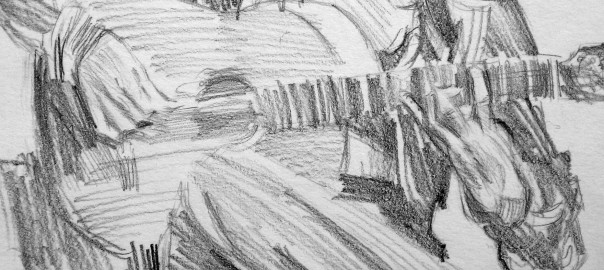
Guitarist drawings project
Over the past two years or so, I’ve managed to fill two or three sketchbooks with studies of guitarists – usually flamenco guitarists. All of the drawings were made from YouTube videos or Web images and the average time spent on each was around three-quarters of an hour. Initially, they were done simply as drawing exercises with the main aim being to record the image as accurately and economically as possible.
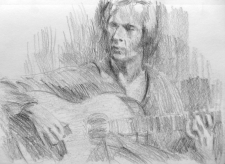 Eventually, I began to experiment with drawing technique to try to suggest the energy and brittleness of flamenco music. The hands of the classical or flamenco guitarist are a fascinating study in themselves – especially the left hand with its strength and flexibility, the square-shaped fingertips and the compositions which the hand creates holding down a chord or fingering a scale passage. The instrument too is a challenge to draw: getting the perspective and proportions correct is difficult enough but trying to find ways to depict the fingerboard or the intricacies of the machine heads without drawing every fret, string and gear is more difficult still.
Eventually, I began to experiment with drawing technique to try to suggest the energy and brittleness of flamenco music. The hands of the classical or flamenco guitarist are a fascinating study in themselves – especially the left hand with its strength and flexibility, the square-shaped fingertips and the compositions which the hand creates holding down a chord or fingering a scale passage. The instrument too is a challenge to draw: getting the perspective and proportions correct is difficult enough but trying to find ways to depict the fingerboard or the intricacies of the machine heads without drawing every fret, string and gear is more difficult still.
The benefits of attempting a lengthy series of studies on a narrow theme are well worth the time and effort involved. They range from the trivia of technique (which makes/grades of pencil and paper gave best results) to the compositional possibilities of a subject which at first sight does not seems to offer too many options.
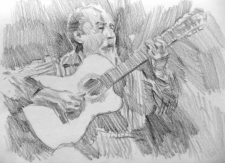 I’ve used a number of these drawings as studies for paintings and in a future post I will show how Photoshop can be used to bridge the gap between a pencil study and a watercolour painting.
I’ve used a number of these drawings as studies for paintings and in a future post I will show how Photoshop can be used to bridge the gap between a pencil study and a watercolour painting.
The Drawings gallery contains a selection of these sketches.
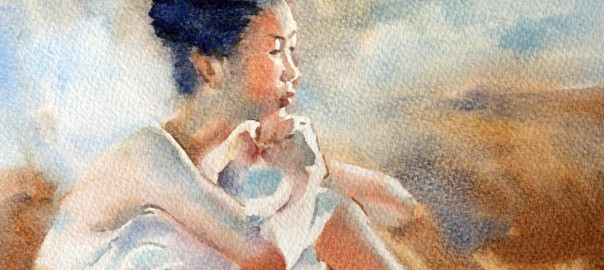
The watercolour technique of Liu Yi
It’s not often that I add a new artist to my list of favourites – especially a watercolour artist. But on seeing the work of Chinese artist Liu Yi a few years ago, I felt he had to be included somewhere near the top of that list. His paintings display an exceptional control of the watercolour medium without sacrificing any of its freshness and spontaneity.
Liu Yi was born in Shanghai in 1958. I first came across his watercolour paintings in an article entitled ‘Destiny With Water’ in International Artist magazine (Issue 50, Aug-Sep 2006). The text of that article, in which he describes his watercolour technique, is available on this site. The paintings, a series of watercolours of ballerinas, can be seen on Liu Yi’s own website.
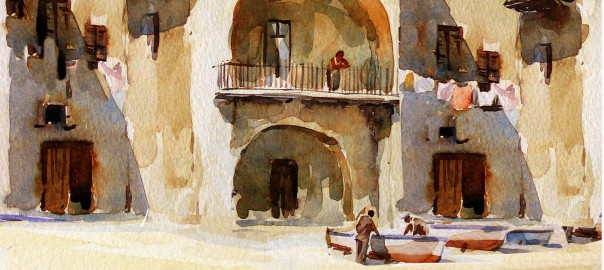
Photoshop for painters: fixing your failures
Being a self-taught artist is something of a two-edged sword. If you make a success of it – find fame, perhaps, or earn a living from it – then you can wear the label as a badge of honour. If, on the other hand, you do as most of us do and make slow and stuttering progress towards something approaching mediocrity then being self-taught is probably best not mentioned – at least, not to the artistically educated. After all, self-taught at best equates to badly-taught and at worst to not taught at all.
Teaching yourself to paint is probably an ill-advised and certainly an inefficient undertaking. Without a tutor to guide you through a structured learning plan, to assess your work and to explain your failures, progress will inevitably be slow and haphazard. You can look forward to periods of drought and discouragement when ideas fail to materialise and your best efforts produce only disappointment. And if you are trying to teach yourself how to paint in watercolour, it can be even worse. Why?
Continue reading Photoshop for painters: fixing your failures
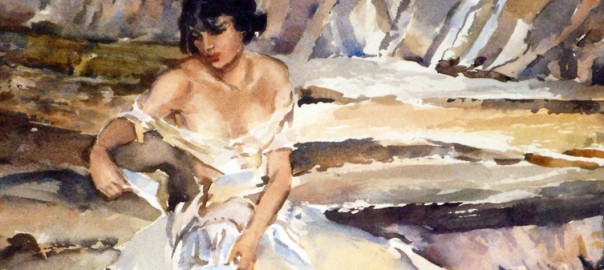
The watercolour technique of Sir William Russell Flint
One of the best ways to improve your understanding of the painting process is to follow the example of the great masters and copy. If you are trying to improve your watercolour technique, copying can be particularly profitable: because watercolour is a transparent medium, it is often possible to reconstruct the artist’s painting process from preliminary drawing right through to final washes. Copying the work of a favourite artist can be both instructive and enjoyable as well as an excellent way to assess your strengths and weaknesses technically. And yet, despite its potential benefits, copying isn’t a widespread method of study among amateur artists.
So what are the benefits of copying? Because copying avoids the complication of composing a painting, it allows the copier to evaluate his ability to handle the painting medium itself without the distraction of composition. Continue reading The watercolour technique of Sir William Russell Flint
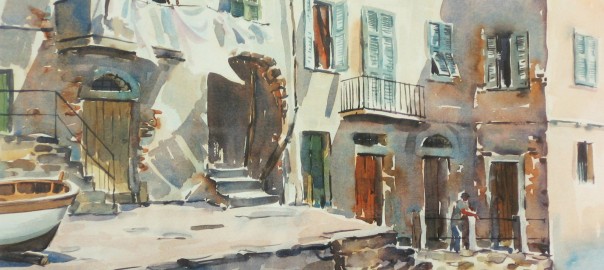
An alternative approach to watercolour technique
watercolour technique: the traditional way
The cornerstone of traditional watercolour technique is learning how to apply washes – the flat wash, the graded wash and the variegated wash. Wash technique stresses the importance of using a fully-loaded brush to create a bead of colour which moves down the paper with each stroke. At the end of the process, surplus water is picked up with a damp or ‘thirsty’ brush. The aim is to produce a wash without any banding or unevenness.
Using washes, the beginner is advised to work in the following ways:
- from general to specific (top-down);
- from light to dark;
- from background to foreground.
A typical ‘how to’ book will include demonstrations of how to paint simple landscapes/seascapes to reinforce the merits of the method. The idea, of course, is to encourage the beginner to believe that with these tools he can make instant ‘art’.
But the feeling of progress doesn’t last – or at least it didn’t for me. Continue reading An alternative approach to watercolour technique
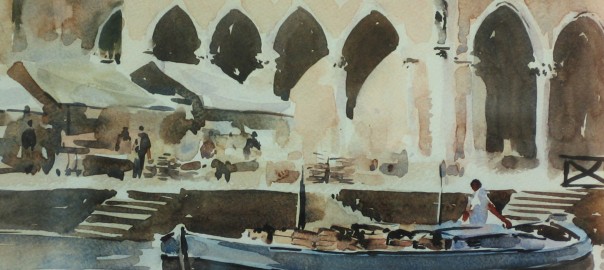
Watercolour for the beginner: the right choice?
Watercolour for the beginner seems to have a powerful attraction. I used to be a member of a local art group. We held regular exhibitions and although a typical exhibition would include a few pastels and an occasional oil or acrylic, the overwhelming majority of paintings would be watercolours. Mine included.
What is it that draws the amateur painter to watercolour? Continue reading Watercolour for the beginner: the right choice?